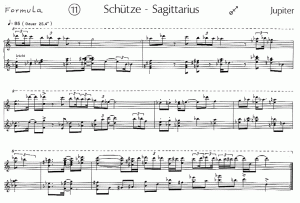Sagittarius Formula
In May of 2002 composer Karlheinz Stockhausen conducted a music contest online. He submitted 12 sound samples, mostly very long examples of various forms of white, pink and other forms of “colored” noise. Along with these samples were very specific instructions of how the excerpts of sound would be transposed onto the formula that he provided. The “formula” provided was Sagittarius from his Tierkreis (Zodiac) suite. The problem that I saw was how to take standard sheet music and apply pitchless samples into something that could be recognized. After some thought, I imported small chunks of the provided noise samples into my Akai S 6000 sampler. I used the sharpest high Q filter that I could find and created unique samples for every pitch that would be used in the piece. For example, for A 440 I created a very sharp filter that would only let noise pass through at or around 440 Hertz. After some trimming and other small edits I stored and mapped the samples across a standard keyboard. I then took the score provided by Stockhausen and manually entered it into Finale. Once the score was complete I played the exported MIDI file in the S 6000 sampler to produce the final audio file which I called “Sagittarius Formula”. Professor Stockhausen granted me “First Runner Up” for the submission of this piece.
For Those Interested, Here Are The Original Instructions Sent By Stockhausen.
Original Instructions as submitted by Professor Stockhausen
To whom it may concern
1. as a “formula” one page with the notation of SAGITTARIUS.
1. This part of my ZODIAC lasts normally 25.4 sec. with the tempo quarter note = 85. For composing a piece of about 3 1/2 minutes, it should be stretched 8 times slower. Inside these 3 1/2 minutes, various transpositions in durations and pitches can be juxtaposed and superimposed. Use ritandandi and accelerandi.
2. All the pitches with their durations should be used at least once in the original form.
3. Use 12 degrees of volume:
Decibel 48 – 52 – 56 – 60 – 64 – 68 – 72 – 76 – 80 – 84 – 88 – 92, like the pitches:
2. I add a DAT-tape with sound samples. After the choice of excerpts, and after the order of sounds has been made, the chosen sounds must be transposed on the pitches which have been fixed beforehand.
Then shape the envelope of every sound, slightly superimpose endings and beginnings of connected sounds. Vary reverberation.
3. Every now and then play and / or sing along with the sections of the computer. Strive for a dancing mood. The original tempo is basically eighth note = 170!
Have Fun!
Yours
Stockhausen
Below Is The Music That I Submitted
